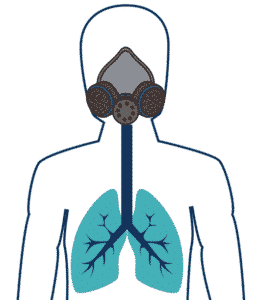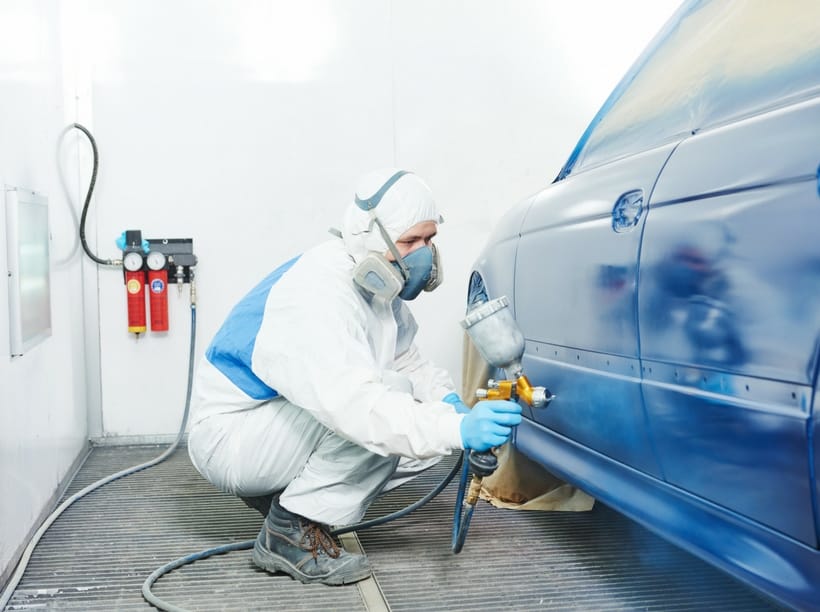Everything you will want to know about the danger of VOCs is here: a good US government website called TOXTOWN. Bottom line: VOC is what makes paint stink. These days, there is no reason not to use low VOC paint. Update: Finally the EPA is going to make VOC standards for spray paint.
I get asked for the best VOC-free paint, so here it is (but there is a lot more to say below). Most Benjamin Moore paints are now VOC and that includes my go-to wall paint* linked here. This does not include tint… read the note that’s next:
But… a technical note:
Colorants can add VOCs to base paint. The colorant s used can vary between different retailers. You should ask the store when you visit about each color you are buying, especially darker colors with a lot of pigments added.
Each ounce of colorant added to tint your paint or HPC may contain anywhere between 5 and 20 grams of VOCs. Dark colors however, could require 5-15 ounces or more of tint, adding up to 300 or more grams of VOCs per gallon of paint.
What is VOC Paint and why should I care to use only low VOC paint?

VOC is a big term and covers many substances. Avoid them all. Ask a paint store for the info, but don’t ask a store such as Home Depot for a low-VOC or zero-VOC paint. They just don’t know as much. Ask about low VOC paint and see what you get!
I will not write about the details here as you can easily find that information because I happen to know it’s on that thing called the internet, but here is the bottom line: we do not use paints that do not list the VOC content.
Our grandparents dealt with black lung, and we should know enough by now to not work around toxins, right? RIGHT? They also did not have low VOC paint.
If you have other sources of VOC vapor, you might need to plop down a big sum for a good filter: there is no cheap solution, unfortunately. You must have carbon filters and of course, the Hepa filter keeps it from getting clogged and removes pollen and other allergens. If you need to work with VOCs, be sure to wear a mask. You can read more on respirator mask here.
We purchased this when we lived in a house that had a real moldy-oldie smell. It keeps a very large room smelling fresh and we trust the brand. Finally, our air became breathable.
Guidelines for low VOC paint:
- VOCs are compounds that contain carbon and that easily become vapors. That means if they are in paints that you are around while they are drying (and for the weeks and months of curing), you will breathe them into your bloodstream. They will hurt you and in the long term and you will suffer long-term health problems. So it’s not worth buying cheap paint!
- If a client buys a paint we are forced to use, we use it only in well-ventilated areas and/or wear a chemical respirator (well worth the money and suitable for many occasions such as the coming zombie apocalypse). I wear mine every time I pick up a spray can or open something stinky and nasty.
- You should be safe with a good respirator, but do your homework and read the safety information on both the respirator and the filter it uses. Note that good ones have 2 filters: one outer filter for dust that you change after several hours as needed (you can tell when it needs to be replaced as it gets hard to draw air), and a chemical cartridge filter that lasts a long time (store these in an air-tight container as they absorb 24-7). Look at the chart on the respirator page linked above. It shows which one fits that model. Get the one that filters chlorine as you might someday be washing something with bleach and yes bleach kills. We know a lifeguard that got sick and died after years of chlorinating the pool indoors.
- Turn on the house’s air circulation, if it has one. Known as “Venmar” among other names, it takes out stale air and moisture and you don’t lose all of your heat/cooling.
- Use a fan to move the fresh air in. We blow fresh air into the room where we are working and we have a second fan nearby blowing out. This style of fan is best for creating suction (outgoing) in a room as it seals the edges.
- A standing fan or desk fan near the incoming window is enough. Do this even in cold weather: it’s worth the discomfort and cost of heat. Don’t cheap out on this. I have a very well-made fan from the 80’s still going strong and I use it hard. I love it. I compared fans on Amazon and if I had to buy one today, I’d buy this or this.
- Create a “booth”. You can hang plastic around the work area to trap much of the air in place while the paint dries. This helps enormously with dust, but not as much as with vapor. These folks did it right, but we usually just use tape (the green expensive stuff won’t pull off paint like the tan stuff that is not for long-term work) and plastic around the wall/object.
- For small spray jobs, I was given this ‘booth’ as a gift. I have not used it yet, but I’m glad I have it. Spray, zip, walk away. Trap the off-gassing. Cool.
Need to know:
Wikipedia lays it out: “Health effects include eye, nose, and throat irritation; headaches, loss of coordination, nausea; and damage to the liver, kidney, and central nervous system. Some organics can cause cancer in animals; some are suspected or known to cause cancer in humans.”
Buy ‘low VOC paint” or “Zero VOC paint” whenever possible, especially in children’s’ rooms. Remember that a ‘zero’ VOC paint can be filled with tint (to make your color) and the tint can be very toxic! So ask about the tint the store is using as well. They may be able to show you colors that will be the least dangerous.
Thank the uber-government of the republickistan of California. As a result of the tree-hugging, they started saving our lungs many years ago. They do have a way with safety out there. Must be the hippie thing. I think I try the hippie lifestyle. Yeah, hmm. I’ll get back to you.
Actually, I lived in California for a while: where painters hoarded the outlawed green-fencing treatment stain. That was just the beginning. Now we owe the wave of non-toxic paints to them. Your high taxes at work!
Which Zero-VOC Paints Are We Using ?
We use Benjamin Moore and Sherwin-Williams. All their non-oil based retail paints are zero VOC paints) but this paint is contractor grade and you may not cover your walls well: it requires a certain touch and quality tools. If you are not very experienced, try Ben Moore Natura or Sherwin Williams Pro Mar 200.
Which tints are zero VOC?
When tint is added, you may be adding toxins. My local Ben Moore store uses only VOC free tints, but not all Sherwin-Willams do. You should ask or read the description if you are buying online, and ask the store what they have.
* This paint is available from the seller in any color: you just pick your color from the Ben Moore website, unless you already have the paint number, then just email the seller thru the product page. It’s shown as ‘seller’ in the product page right-hand column.
As always, contact us if you have a very good darn reason!
Here is a video showing the exhaust fan by someone who reviewed it.


Hi Brad, we just moved into a house where the seller seemingly threw large amounts of varnish on the floor at one time and sealed up the house over the winter. We are experiencing massive amounts of VOC offgassing. We figured a little airing out would take care of it, but a week and a half later it is still hard to be in the house. We borrowed an airscrubber and have been opening windows anytime it’s not raining. Any ideas? Do we need to refinish the floors again to get rid of this? I know this is an old post but any ideas would help!
Yes you very well may need to scrape it off. If hardwood floors, the pros will know what to do.
I would guess the smell will vanish after a while once you get the spill up.
Not sure the VOCs are present though. They ususally off-gass quickly, but you cannot be too safe.
Good luck.
B
Waht is the best way to paint a particle board subfloor that is going to be used for a pickle ball court and dance exercise and tai chi studio. We want to use something that is low or zero VOC.
PrimeLock and then Tough Shield is my choice…But are you sure you want to dance on particle board? Going to sand it very smooth first? In anycase, the oil primer and top Q floor paint. GarageGuard may be better if you can handle a 2-part epoxy paint. Read about that on my Garage paint post. Good luck!
Thanks for your post. Our estate agent had a high VOC gloss put on the back of the front door before we moved into the new flat the other week, been on for over a week but still smells and you can feel it in your nose. Wanted to paint over it with Zinsser Bulls Eye 123 water based Sealer and Primer *Plus* (very low VOC), will that help with the off gassing?
Hi and thanks for writing.
Well, this is a tough one. I cannot imagine what they used that still smells.
Here are your options and I’d advise the 2nd.
1-yes, go over it with a shellac based primer (alcohol based nasty) I would say BIN, not the 123.
This seals it in, but then you still have this poison in your home.
So,
2… Paint remover.
I’m about to write a post on that awful business… I have used citrus strippers and old fashioned toxic strippers… the old way is faster and better and eaiser.
I’d advise getting that stuff out of your house.
You may also want to put a space heater near it…careful, I’m guessing it is still flammable!
This will speed up the off-gassing.
Let me know how it goes?
Good luck!
Brad
Had lots of alkyd oil base painting done in our flooded house rebuild. How long does it take for the offgassing to slow down to a safe level?
Hi and thanks for writing. Well, we generally say that off-gassing takes a couple of months to be complete, but after a couple of weeks in the summer months, or a month when the house is cooler, you will be rid of most of it. You will have that ‘new paint’ smell for a long time, but that is not necessarily dangerous. Keep a window cracked all day and night if you can to stay safe. If you remember your math class, the decay in VOC levels is logarithmic, meaning that it is far worse in the first days than in later days.